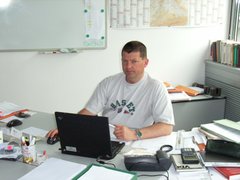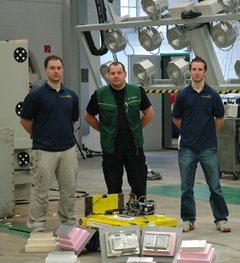Since 80 years DEKRA is working side by side with the automotive industries as a professional and neutral partner, especially in the field of vehicle scrutiny, expertise and valuation. As the technological partner of the Formula Student Germany, DEKRA is checking a long time prior the competition the safety of all 78 participating vehicles. Specialist Axel Struck and Project Crash Test Engineer Bernd Hund analyze SEF (Safety Equivalency Form) and IAF (Impact attenuator Form) reports of up to 100 pages.
 At the beginning of May, all 78 teams had to hand in their SEFs. Depending on the variation of the safety structure from the rules, the volumes of the reports were between two and a hundred pages, where Axel Struck had to recalculate and check the numerical values regarding logical aspects. The report turns out short, if just the diameter of a tube was changed and just contains calculations. If the teams are using sandwich- or carbon constructions instead of tubes, the SEF contains more pages. In addition to all calculations the SEF comprises explanations and test trials of safety proof of the deviant constructions. “Editing the SEFs is very interesting”, Axel Struck reports, “but it is also a very time consuming work”. Most of the time Axel Struck needs for checking up the reports. Many teams get to know the man behind the SEF, if Struck gets in touch with the team for asking questions for better understanding, for explanations of the report or to point at mistakes.
At the beginning of May, all 78 teams had to hand in their SEFs. Depending on the variation of the safety structure from the rules, the volumes of the reports were between two and a hundred pages, where Axel Struck had to recalculate and check the numerical values regarding logical aspects. The report turns out short, if just the diameter of a tube was changed and just contains calculations. If the teams are using sandwich- or carbon constructions instead of tubes, the SEF contains more pages. In addition to all calculations the SEF comprises explanations and test trials of safety proof of the deviant constructions. “Editing the SEFs is very interesting”, Axel Struck reports, “but it is also a very time consuming work”. Most of the time Axel Struck needs for checking up the reports. Many teams get to know the man behind the SEF, if Struck gets in touch with the team for asking questions for better understanding, for explanations of the report or to point at mistakes.
 The Impact Attenuator Form had to be handed in by June 1st. Within this form, the teams had to explain their front crash box, which has to absorb the forces of an accident. The rules show the basic data: deceleration value, speed, minimum rod measurements, forces and energy absorption. The design is mostly done by calculations depending on the solidity values of different crash box materials. To proof the safety, most teams create simulation models or execute real crash test. Bernd P. Hund, project crash test engineer of DEKRA, recalculates the calculations and checks the specifications, which are reported be the students on up to 20 pages. In case the calculations are not comprehensible, Bernd Hund asks the team for support in answering his questions. “The easiest way to proof the safety of the crash box is, if a real crash test is accomplished”, recommend Hund. Thereby special data recording, in this case acceleration sensors, deliver the necessary results, which just have to be compared with the rules. A crash test can be done by the team at an independent institute e.g. DEKRA.
The Impact Attenuator Form had to be handed in by June 1st. Within this form, the teams had to explain their front crash box, which has to absorb the forces of an accident. The rules show the basic data: deceleration value, speed, minimum rod measurements, forces and energy absorption. The design is mostly done by calculations depending on the solidity values of different crash box materials. To proof the safety, most teams create simulation models or execute real crash test. Bernd P. Hund, project crash test engineer of DEKRA, recalculates the calculations and checks the specifications, which are reported be the students on up to 20 pages. In case the calculations are not comprehensible, Bernd Hund asks the team for support in answering his questions. “The easiest way to proof the safety of the crash box is, if a real crash test is accomplished”, recommend Hund. Thereby special data recording, in this case acceleration sensors, deliver the necessary results, which just have to be compared with the rules. A crash test can be done by the team at an independent institute e.g. DEKRA.
The review of SEF and IAF is an important base for the scrutineering and dynamic events for the competition in August. DEKRA supports the Formula Student Germany prior and during the event as the technological partner for safety.


